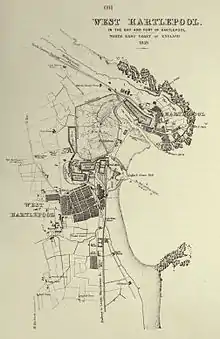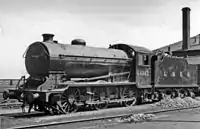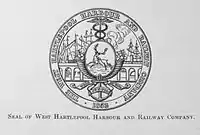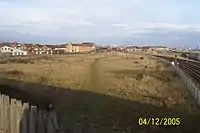West Hartlepool
West Hartlepool refers to the western part of what has since the 1960s been known as the borough of Hartlepool in North East England. It was originally formed in 1854 as the result of the opening of seaside docks and railways that connected the docks to Leeds and other cities.[1][2]

History
The town of West Hartlepool was founded by Ralph Ward Jackson who went on to become managing director of the Stockton and Hartlepool Railway in 1848.[3]
The area, having just one farm house in 1845, steadily grew into a centre for shipping and railway transportation.[2][4] The West Hartlepool Harbour and Dock (8 acres (0.032 km2)) opened on 1 June 1847. Five years later, also on 1 June, the Jackson dock (14 acres (0.057 km2)) opened as well as a railway connecting West Hartlepool to Leeds, Manchester and Liverpool. This allowed the shipping of coal and wool products east, and the shipping of fresh fish and raw fleeces west, and the area's population grew as a result.[2] Eight shipbuilding yards were established.[4] Supporting shipbuilding and repair were: a canvas manufacturing firm, Bastown Brothers and W. Taylor iron foundries, block and mast makers and other related machinery.[5]
Streets were laid out along which shops and brick homes were built. Standard town services followed including paved roads, gas and electricity, sewers, a slaughterhouse, cemetery and more.[4]
West Hartlepool was formed in 1854 by the Bishop of Durham.[4] Swainson Dock opened on 3 June 1856, named after Ward Jackson's father-in-law. In 1878 the William Gray & Company ship yard in West Hartlepool achieved the distinction of launching the largest tonnage of any shipyard in the world, a feat to be repeated on a number of occasions.[2]
The municipal borough of West Hartlepool was created in 1887, and, with its headquarters at West Hartlepool Town Hall,[6] it was promoted to the status of county borough, outside the control of Durham County Council, in 1902.[7] In 1967, a county borough, called Hartlepool, was established by amagamating West Hartlepool with old Hartlepool.[8][9]
Sport
The town's Rugby Union football team was formed in 1881 by men who came to the area to build the railway and dig the docks, and continued until 1908 when the Hartlepool Union's round ball game was in vogue.[10] Until 1977, the football team now known as Hartlepool United was shown in the plural - Hartlepools United - to show its links to both Hartlepool and to West Hartlepool.[11]
Notable people
- Margaret Green, artist, born in West Hartlepool[12]
Gallery
 West Hartlepool Locomotive Depot
West Hartlepool Locomotive Depot West Hartlepool harbour and railway seal
West Hartlepool harbour and railway seal View from Newburn Bridge. This is the site of the old railways sheds in West Hartlepool.
View from Newburn Bridge. This is the site of the old railways sheds in West Hartlepool.
See also
References
- "West Hartlepool History". This is Hartlepool. Retrieved 28 February 2020.
- Lionel Alexander Ritchie, Gray, Sir William (1823–1898), Oxford Dictionary of National Biography, Oxford University Press, 2004 accessed 2 May 2011
- "Jackson, Ralph, Ward". Hartlepool Then and Now. Retrieved 4 February 2021.
- Whellan, William, & Co. (1856). History, Topography, and Directory of the County Palatine of Durham. Whittaker and Company. p. 533.
- Whellan, William, & Co. (1856). History, Topography, and Directory of the County Palatine of Durham. Whittaker and Company. p. 534.
- Historic England. "Town Hall (1250394)". National Heritage List for England. Retrieved 4 February 2021.
- "West Hartlepool MB/CB". Vision of Britain. Retrieved 4 February 2021.
- "Local Government Boundaries (Hartlepool)". House of Commons Debates. 7 February 1967. Retrieved 4 February 2021.
- "Hartlepool Order 1966". House of Lords Debates. 8 February 1967. Retrieved 4 February 2021.
- Picken, Dave. (29 April 2010). West Hartlepool Rugby: A Short History. West Hartlepool Rugby. Retrieved 8 September 2012.
- "Club History". Hartlepool F. C. Retrieved 4 February 2021.
- Buckman, David (1 December 2003). "Margaret Green: Painter inspired by coastal Suffolk". The Independent. Retrieved 5 May 2019.
External links
- Alan Godfrey Maps
- Rob Whitton talks about Hartlepool, History, and H'Angus the Monkey - much about Hartlepool, but also some about West Hartlepool
- Early morning, West Hartlepool, County Durham, 1963.